Mars Mission Travel Log: Day 153
Entry by Captain Lee, aboard the Muskian VII
November 12, 2037- 08:38 PM JST: Mars’ red expanse appears as a faint yet evergrowing dot on the horizon, mocking us as our 5 month journey starts to fray. The 2nd oxygen recycler failed again today, and Pilot Jaxon’s emotional outburst, angrily yelling in panic, shattered our fragile calm. It was hard to stay clearheaded enough to diagnose the mechanical problem while keeping an eye on his erratic behavior. Engineer Rogers couldn’t figure out why it broke and gave up midway through a shoddy repair job. Roy the Youtuber is unbearably annoying with his constant extraverted yapping in this confined capsule. We need total cooperation to fix this air recycler issue while simultaneously piloting the craft, yet this crew just cannot get along. Cabin fever tightens its grip, and I hope no one snaps. Every little inconsiderate habit feels amplified in this space hut- Timothy directly staring at me, Fernando absentmindedly whistling, Dimitri not using the air vent when flatulating. I often suppress my rage at their lack of sensitivity for others. I wonder if the cold vacuum of space is better than being trapped here with these idiots. If we make it back to Earth in one piece, I will sue whoever selected these crew members.
The Space Age has begun. Elon’s reusable SpaceX rockets and the many space companies he has inspired around the world has turned our sci-fi space colonization fantasies into an economically feasible reality to be realized in the upcoming decades. Humanity tingles with excitement at the prospects of multiplanetary life. Yet, the psychological and sociocultural aspects of deep space missions and otherworldly colonization remain poorly understood by most. We assume we can just transplant our local communities and friend groups directly into a multi-year space voyage, or into a fledgling Mars base, and expect to socially function as we usually do. But that is not the case. How do you know you would stay sane during a year long space voyage in a cramped starship far away from civilization? Is everyone equally suited for such an endeavor? Spacetravel researchers discovered that having certain personality traits and sociocultural values are critical to survive and function cohesively in such extreme environments.
What is psychologically and socially challenging about space travel, and who is best suited for it?
Spacecraft travel and extraterrestrial bases are a distinct psychosocial environment unlike anything we are familiar with. Such an environment is considered by personnel psychologists to be an ICE (Isolated, Confined, and Extreme) environment (Golden et al., 2018).
Isolated- meaning far beyond humanity’s reach, inescapable with no external aid available, bound to a small lonely crew for months or years on end.

Confined- meaning surviving within a small, limited space indoors environment, with minimal personal privacy, in constant close proximity with other people that you must get along with.
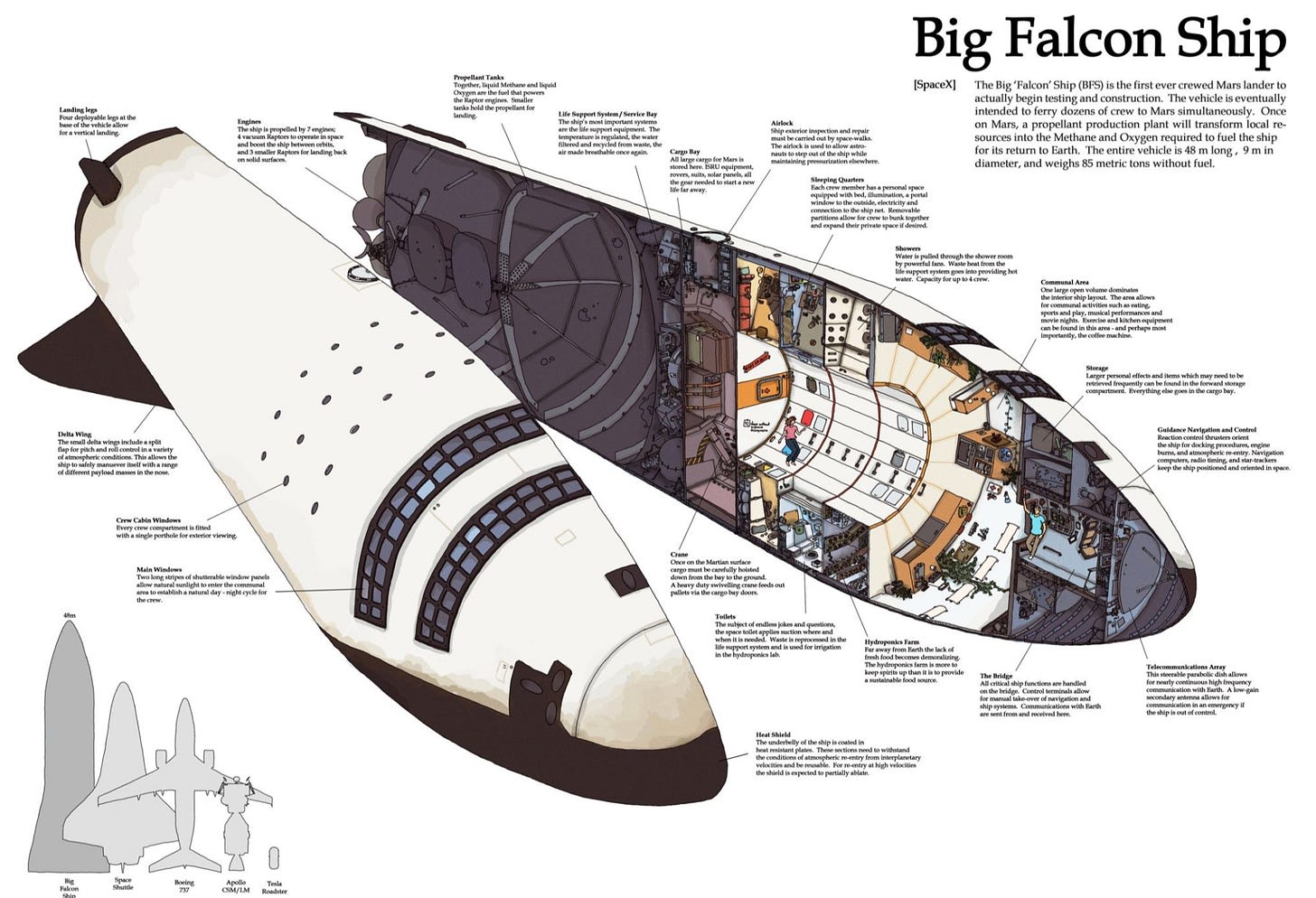
Extreme- meaning surrounded by a deadly and unusual environment, whether it’s the vacuum of space, or a new planet’s toxic unbreathable surface, both guaranteed to kill you if your fragile habitat fails or if you are kicked out by your crew. An environment quite unlike our typical urban habitat.

A mission to Mars, which is currently under planning by SpaceX, certainly qualifies as an ICE environment. Spacecraft voyages take about 9 months with current technology to reach Mars. After taking off from Earth, you are stuck in a tiny, confined vessel for about 200 days with a small crew you cannot escape from, and that you are wholly dependent on for survival, companionship, and mission completion. This tiny, fragile dwelling hurtles through the lethal vacuum of space at ~100,000mph, running on a precise technological order requiring the perfect synchronization of millions of intricate mechanical parts and tens of millions lines of software code, all while burning a limited reservoir of explosive fuel. A single failure could end it all. Upon arrival on an unterraformed Mars, the environment is just as ICE as deep space travel- a small confined base in a foreign planet with no oxygen to breathe, a near vacuum air pressure, polar levels of -60 degrees cold, lethal surface radiation from lack of a magnetic field, and an atmosphere of toxic dust. The psychological and social challenges of an isolated Mars base thus mirrors that of deep space.
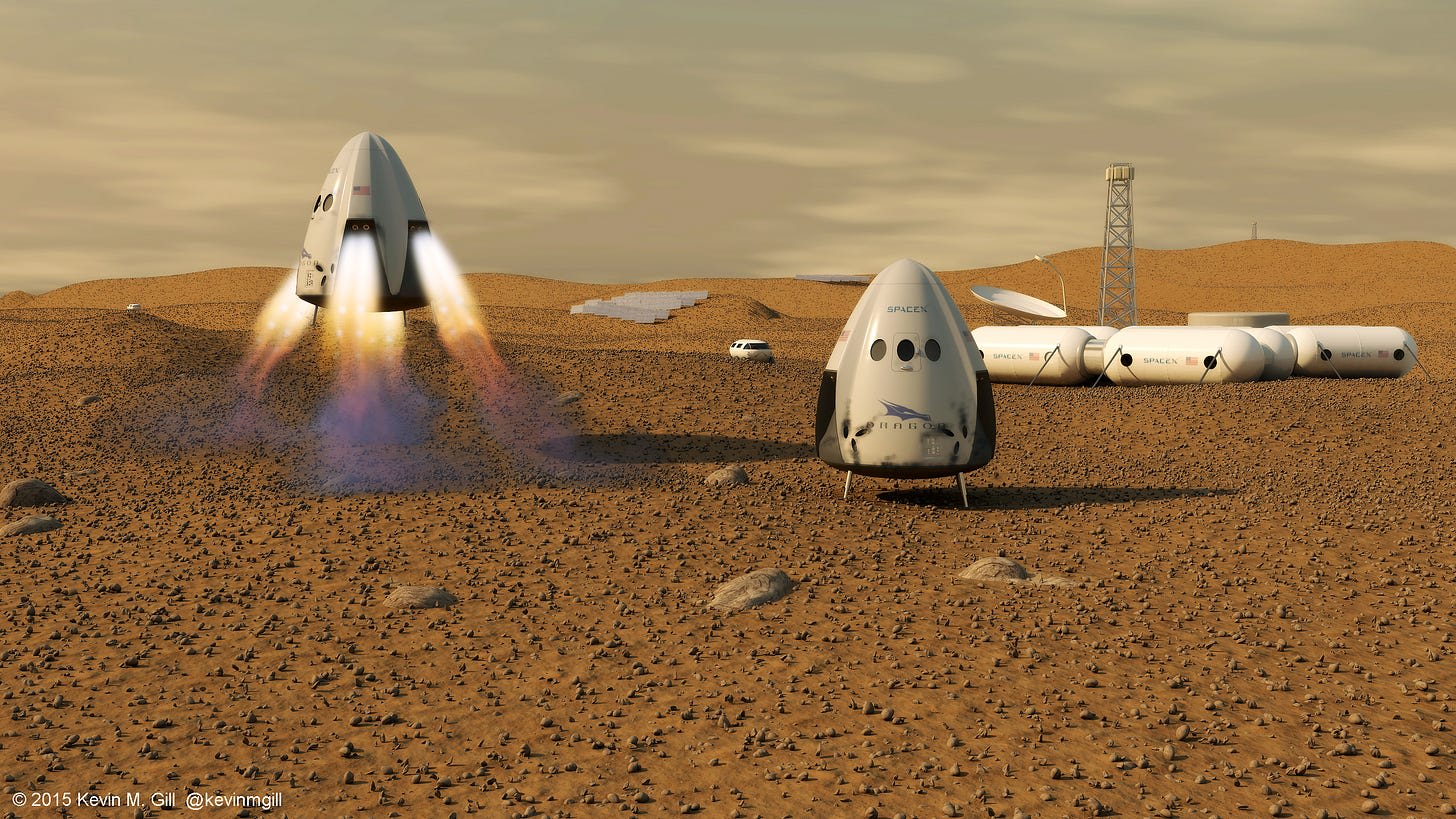
Typical life risks are exacerbated to an extreme level in an ICE environment. What happens if a crewmate snaps and becomes violent in this confined and inescapable capsule? Death. Your crewmates start to disfavor you or think your survival is of less priority than others? Death. Someone slacks off or disrupts the precise cooperative work needed to maintain the habitat? Death. Teammates become too incompetent or can’t figure out how to repair the spacecraft or base? You guessed it- Death. In the unforgiving environment of outer space, there are unlimited ways for the entire group to die, but only a few specific ways to survive.

So what personality and sociocultural values are needed to survive in such an ICE environment? Personnel psychologists have studied this topic for decades using similar environments on Earth. The ICE space travel and extraterrestrial base environments are deemed analogous to a few specific earthly environments- high altitude expeditions like Mt. Everest treks, submarine missions deep under crushing water pressure, and isolated polar outposts or group treks in the lethal cold.
The most widely studied ICE analog of space environments are polar base environments, frequently used as training grounds for hypothetical Mars and deep space missions (Bishop et al., 2010). The challenges of isolated, prolonged group confinement dynamics are near identical in both space and polar regions- you quickly die in the -80 degree arctic cold if you’re kicked out of the station by your crew, or your entire group dies if someone breaks the life support heating and food system, or if your group’s supply sled falls down a tundra ravine on a polar trek. For decades, polar psychologists have conducted extensive psychological tests of personnel before, during, and after deployment, and then linked their personality traits and various psychometrics to the resulting success and failure rates- as determined by mission objective completion, peer and supervisor ratings, injury or death rates, and psychological health. The data from these findings are used by Western national polar programs to craft personnel selection criteria for ideal polar candidates, and analogously for ideal deep space mission candidates.
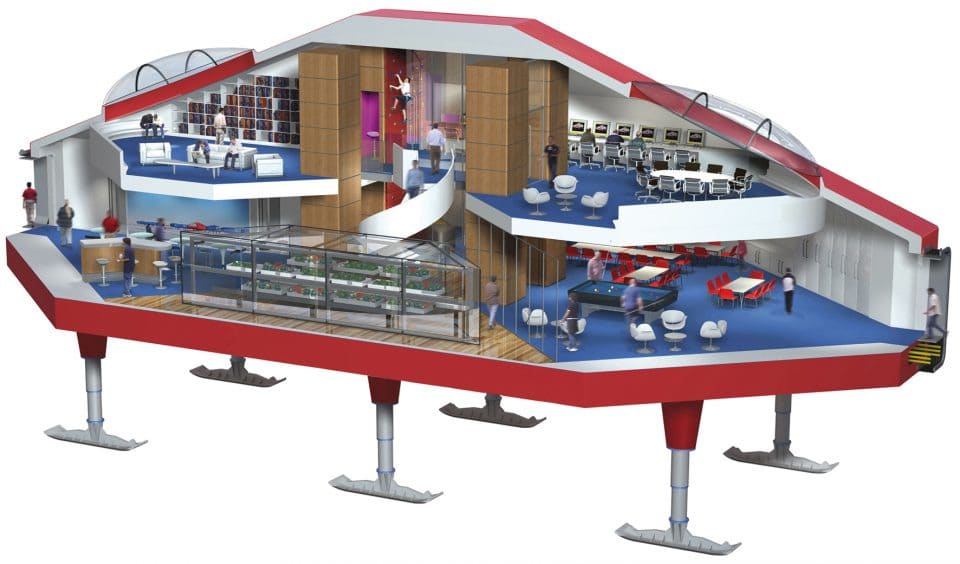
The traits critical for success and adaptation to an ICE polar environment, and thus a space environment, is generalized by US Navy polar psychologists as Emotional Stability (emotionally stable, calm, and even tempered), Task Ability (hardworking, persevering, motivated, industrious even under extremely adverse conditions), and Social Compatibility (likeable, considerate, friendly, and harmonious) (Gunderson, 1974). The opposite traits were linked to poor performance or failure, as noted by Biersner and Hogan (1984).
“Individuals with high needs for novelty and new sensations, whose thoughts and actions are routinely unconventional, who are emotionally unstable, or who are unconcerned with social approval seem unsuited for work in such environments regardless of their technical competence. The opposite is true for those who adjust well. (p. 495)”.
To elaborate on specific workings of these broad traits, a review of the data used to create this polar selection criteria reveals just exactly why they are adaptive.
Emotional control: When you’re stuck in a small fragile station in the arctic winter or lumbering through the polar tundra with a dozen strangers, a single meltdown or rash behavior can be fatal for the entire group. The primary adaptive challenge of confined polar stations is described as “Tension control: the necessity of controlling aggressive and emotional impulses” (Gunderson, 1966). Psychologists ranked emotional repression as a common coping method and favorable personality trait in both small stations and on polar treks, linked to lower stress and positive peer ratings. A necessity to maintain group cohesion and mental clarity in an environment of extreme consequences. The trapped Antarctica researchers news from earlier this year illustrates what can go wrong:
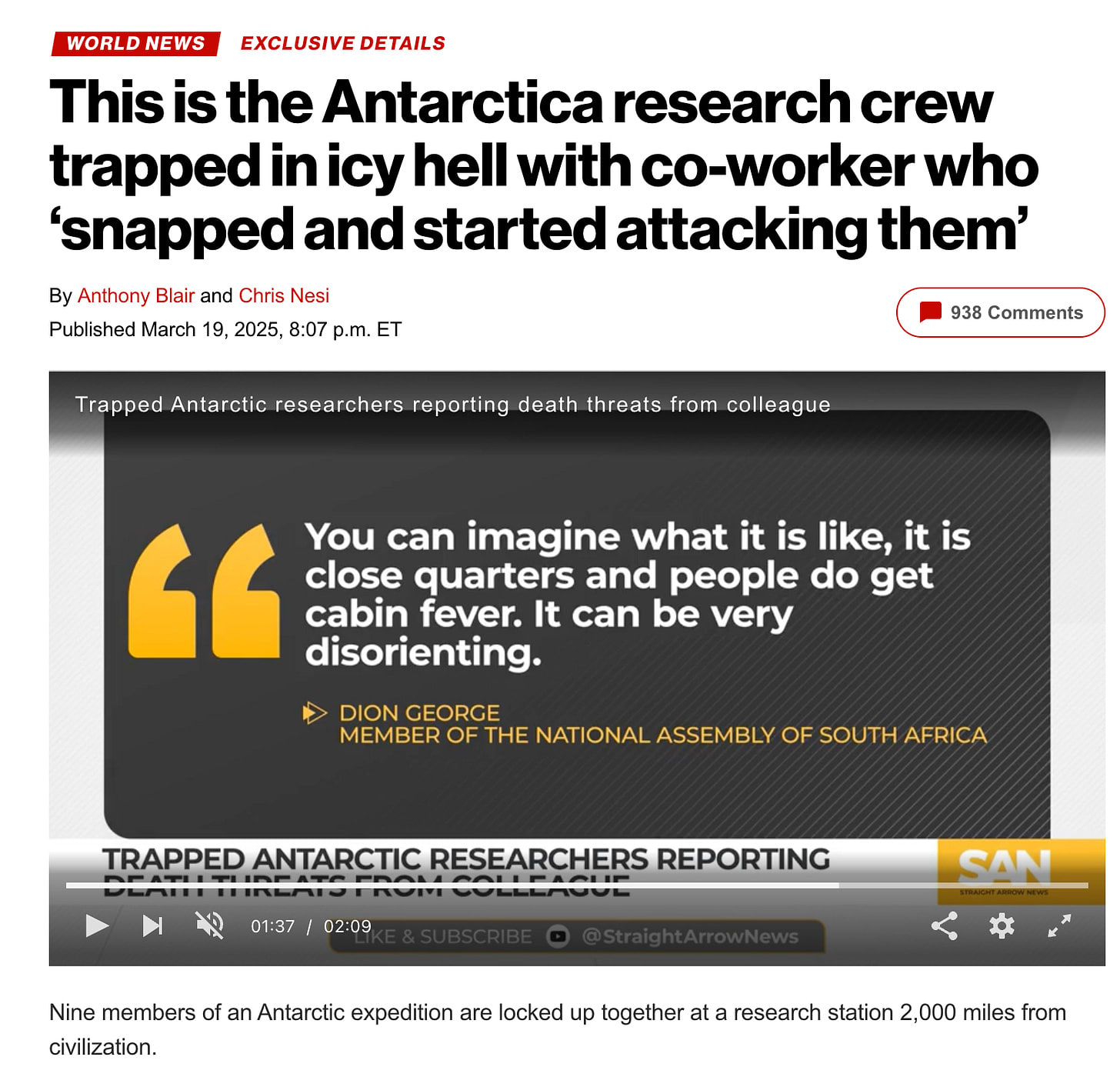
In-group harmony/cohesion: All you have in the isolated arctic is your small group. Cabin fever cause a “goldfish bowl” phenomenon, where small conflicts easily became disproportionate. Polar psychologists note that conflict and tension were the greatest source of stress, and that conflict avoidance was the main priority. The most individualistic people still spontaneously adopted collectivistic thinking and values in polar environments- top performers were highly unassertive, humble, non-dominant, conformist, indirect, with low divergent thinking.
Self-consciousness & social sensitivity: If being booted out of the polar (or Mars) station means instant death, it’s imperative to know exactly how your roommates feel about you. After expeditions, polar staff became better at reading each others’ nuanced emotions and behavior, more self conscious of their own behavior and group approval, and stressfully concerned about self image in the eyes of the team.
Introversion: Imagine being stuck in a small hut or space capsule with an extravert who is constantly yapping his head off. It would be unbearably annoying for the team and possibly fatal for the yapper. Polar staff consistently became more introverted, reserved, and private over the course of a winter. Introversion was linked to high performance and peer ratings. The ideal polar expeditioner was noted to be a “self-sufficient introvert, low on emotional expressiveness” (Burns and Sullivan, 2000). Introversion likely helps maintain group harmony, prevent mutual annoyance, maintain inner sanctity and personal territory in group confinement, and to conserve mental energy.
Cautiousness: Simply being in ambient cold temperatures induces risk aversion in people. Now add lethal consequences to the smallest of mistakes. Traditional Inuit life had a constant high risk of human loss, and most Inuit including children have experienced the death of a close one due to outdoor accidents or illness. Even the boldest polar expeditioners became more cautious after a crewmate death. Polar staff became less bold, less sensation seeking, less lively, less extraverted, and less open to experiences after polar experiences. Those who were highly cautious were considered well adjusted to polar winters.
Perseverance: The ability to be motivated and industrious in extremely adverse conditions was a core trait of polar personnel selection criteria, known as Task Ability. Polar staff and expeditioners were measured to become more perfectionist over the course of a winterover or ski trek, and soldiers with high Hardiness and Commitment traits had more successful ski marches.
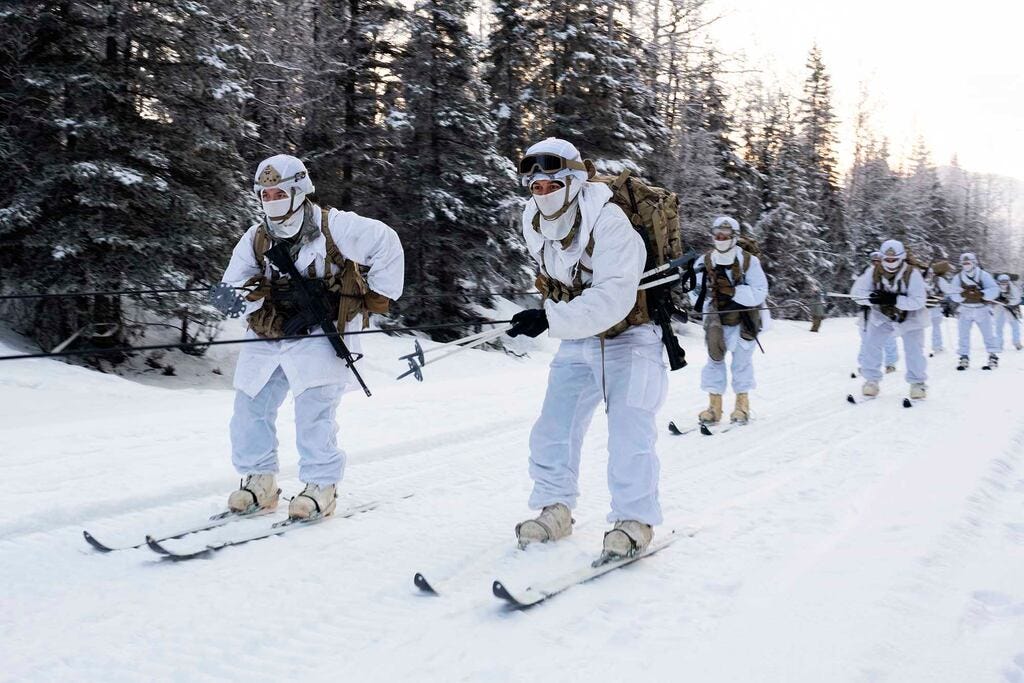
Thus, for polar and space programs to maximize their chances of success and survival in an ICE environment, they ideally need to select candidates who can reliably be highly emotionally controlled, socially cohesive (unassertive, conformist, indirect, humble, etc), self conscious, socially sensitive, introverted, cautious, with high perseverance and industriousness.
As the Space Age accelerates, and space infrastructure, travel, and industries grow to become central to the world economy and humanity’s future, will there be enough people with this very specific combination of personality traits to meet ever growing staffing demands? Are these personality traits equally distributed across the world, or do certain societies have a higher frequency of it? If these traits are so critical for ICE survival, it stands to reason that populations historically adapted to such environments might have developed them.
There indeed happens to be specific populations that evolved in ICE environments.
It has been known for decades now that the ancestral populations of modern East Asians, specifically Northeast Asians and their diaspora who have high Ancient Northern East Asian admixture- experienced many millenia of extreme cold selective pressures in the ICE extreme cold environment of Ice Age Siberia and Northern China around the Last Glacial Maximum period of the late Pleistocene, roughly ~26k years ago to ~16k years ago. This evolutionary period in a polar analogous climate shaped the vast majority of distinct East Asian physiological, morphological, genomic, medical biomarkers. Morphologically, with the highest global frequency of epicanthic eyefolds (Kwon & Nguyen, 2015), unique inner eye structures leading to high rates of primary angle closure glaucoma (Price & Lannon, 2023), general body proportions of longer torso length and shorter lower limb length consistent with Bergmann and Allen’s biogeographical rules of cold adaptation (Guthrie, 1996; Hanihara, 1974). Genetically, with directional selection on EDAR V370A (Mao et al., 2021), variants on TRIB2 (Nakayama et al., 2013) and LEPR genes (Sazzini et al., 2014) linked to thermogenesis advantages, on ABCC11 gene linked to odorless sweat (Yoshiura et al., 2006), on FADS gene linked to Vitamin D transmission (Hlusko et al., 2018) and on ADAM17, ATRN, and OCA2 genes (Norton et al., 2007) linked to lighter skin adaptations to low UV environments. Genomically, with genetic data showing ancestral East Asians going through a more severe Ice Age bottleneck event (sharp population reduction) than ancestral Europeans due to the events of the Last Glacial Maximum (Keinan et al., 2007). This vast body of evidence from multiple fields converges to show that East Asians are indeed predominantly adapted to ICE arctic climates.

In addition to being physiologically, genetically, morphologically adapted to polar environments- it was recently discovered (by yours truly) that East Asians are also highly likely to be psychologically adapted to polar Isolated Confined Extreme environments (Sun, 2025). This “Arcticism” theory of East Asian psychology was published in the peer reviewed American Psychological Association journal Evolutionary Behavioral Sciences earlier this year https://psycnet.apa.org/fulltext/2025-88410-001.html . Using a cross cultural comparison of East Asian psychological data with that of the native Inuit and Siberian peoples of polar climate and confined igloo environments, I discovered multiple shared complexes of psychological traits and psychometric patterns that happen to align with those identified by polar psychologists as adaptive for, or byproducts of, ICE polar survival. These traits that were present in cold adapted East Asian and Inuit/Siberian people were notably absent or far less frequent in non-cold adapted South Asian populations who, like East Asians, are also collectivist Asian societies with many millenia of intensive farming and dharmic religions.
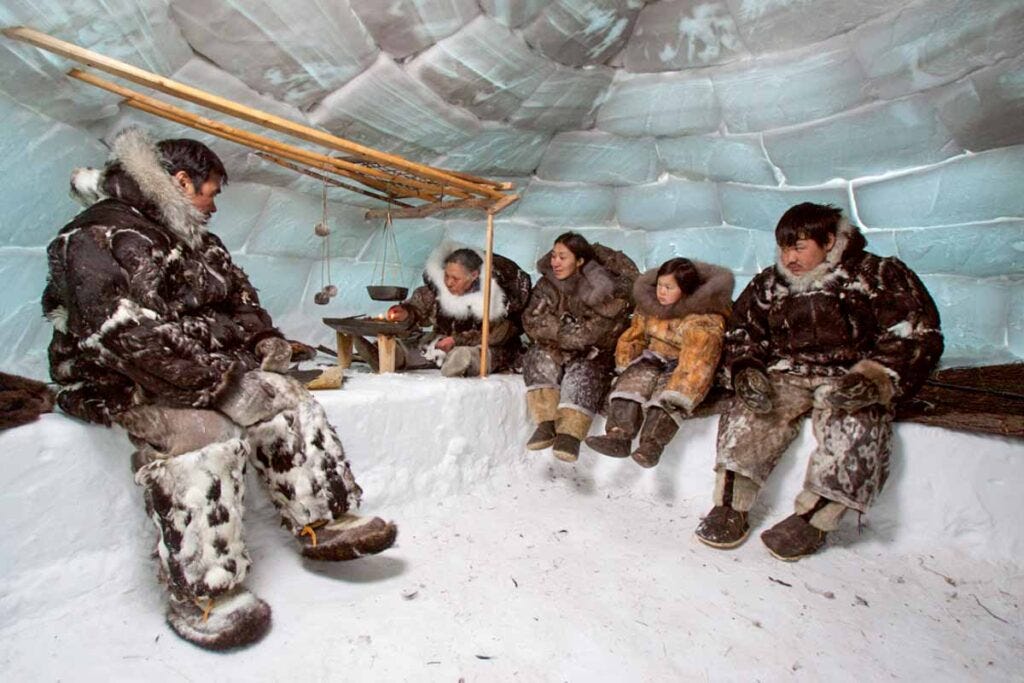
Parsimoniously fitting with the ideal polar candidate selection criteria (and thus analogously spacecraft and base personnel selection criteria), both East Asians and Inuit have strong general expressions and frequencies of the aforementioned ICE adaptive psychological traits, compiled in detail in my paper (Sun, 2025) which I will briefly summarize:
Emotional control: East Asians consistently psychologically test to have lower emotional expressiveness against Europeans, Latin Americans, Africans, South Asians, replicable in both adults and children. They tested on Big Five studies to have significantly lower Impulsiveness than Europeans despite higher Anger-Hostility levels. The same results were verified via neuroimaging studies showing faster suppression of emotional activity compared to Europeans after viewing an emotional trigger. Inuit/Siberians/Northern Native Americans were described by most anthropologists as highly emotionally suppressive, and similarly tested to have lower Impulsiveness than European Russians despite higher Anger-Hostility.
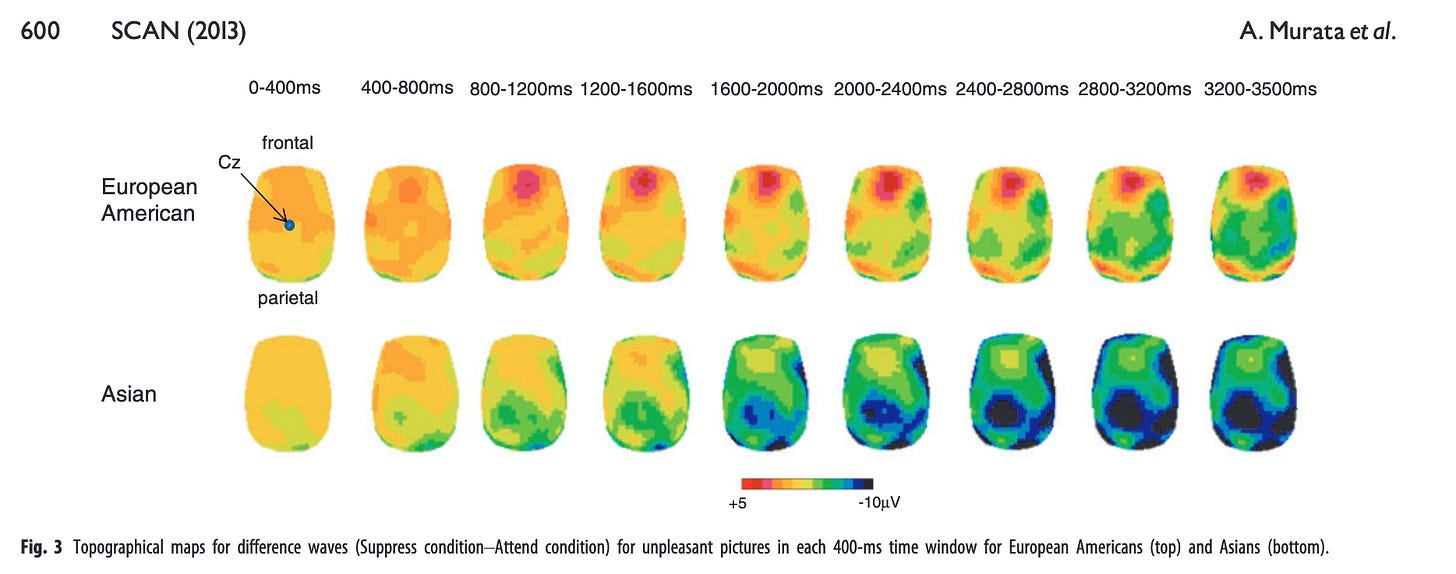
In-group harmony: Both East Asians and Inuit/Siberians were described by psychologists and anthropologists as (within the ingroup) notably nonconfrontational, unassertive, indirect, cohesive, modest, with high surface level politeness, and both tested to have significantly lower Big Five facet Assertiveness than Europeans.
Self-consciousness and social sensitivity: East Asians and Inuit/Siberians are both described by anthropologists and psychologists to be highly sensitive to criticism and shame, reliant on subtle reading of emotional cues and indirect arguing in order to avoid harmony disturbing refusals, less likely than other populations to share personal problems and ask for social support, and have higher Big Five facet trait of Self-Consciousness than Europeans.
Introversion: Both East Asians and Inuit/Siberians are described by anthropologists and psychologists to be highly introverted, and test to have significantly lower Big Five Extraversion levels than Europeans, with East Asians the lowest among all world regional populations.
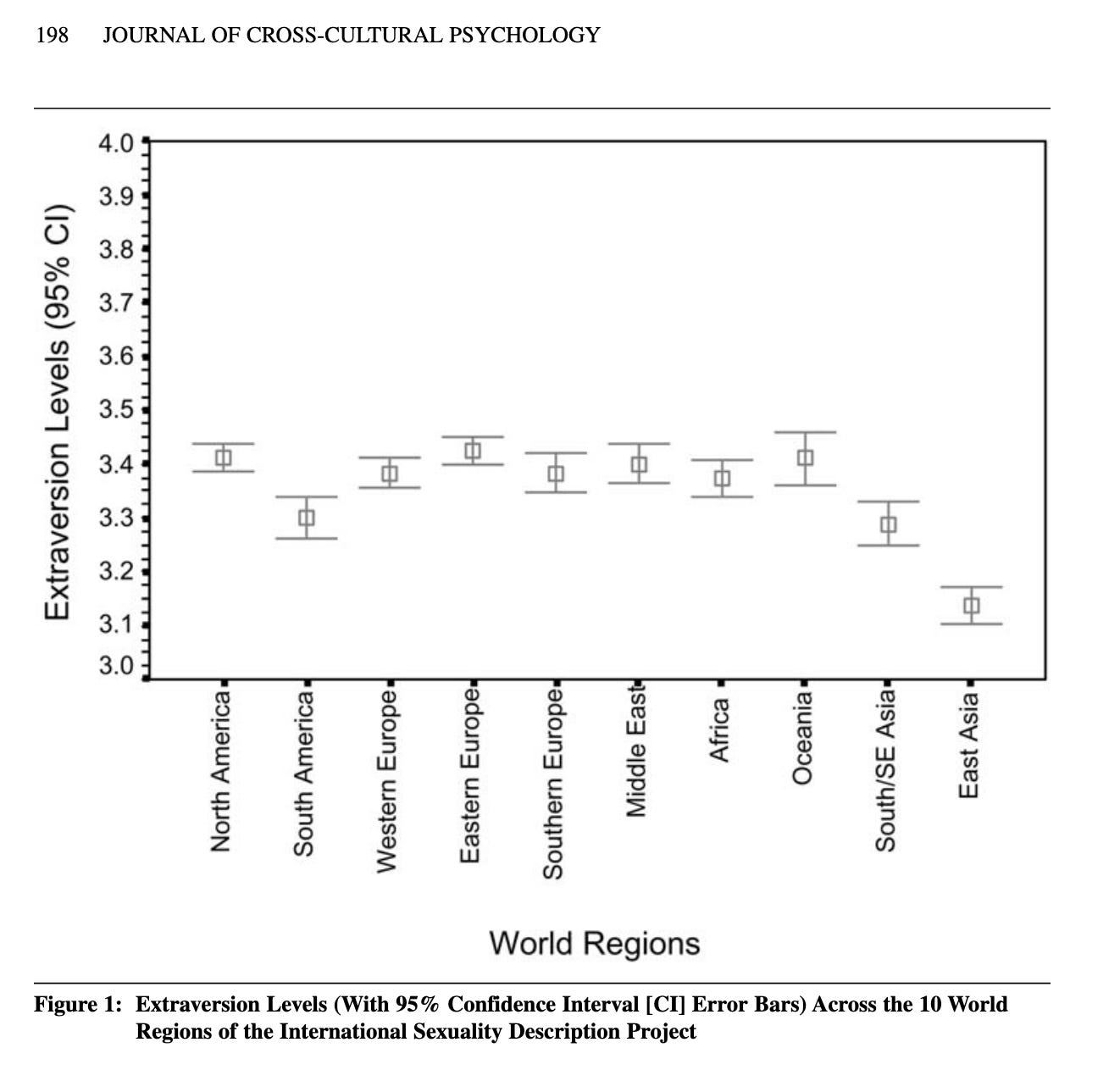
Cautiousness: Both East Asians and Inuit/Siberians are described by anthropologists as generally cautious and risk averse, with cautious and precise intellectual patterns, and a personality pattern of low Extraversion and Openness to Experience that form low Risk Propensity tendencies.

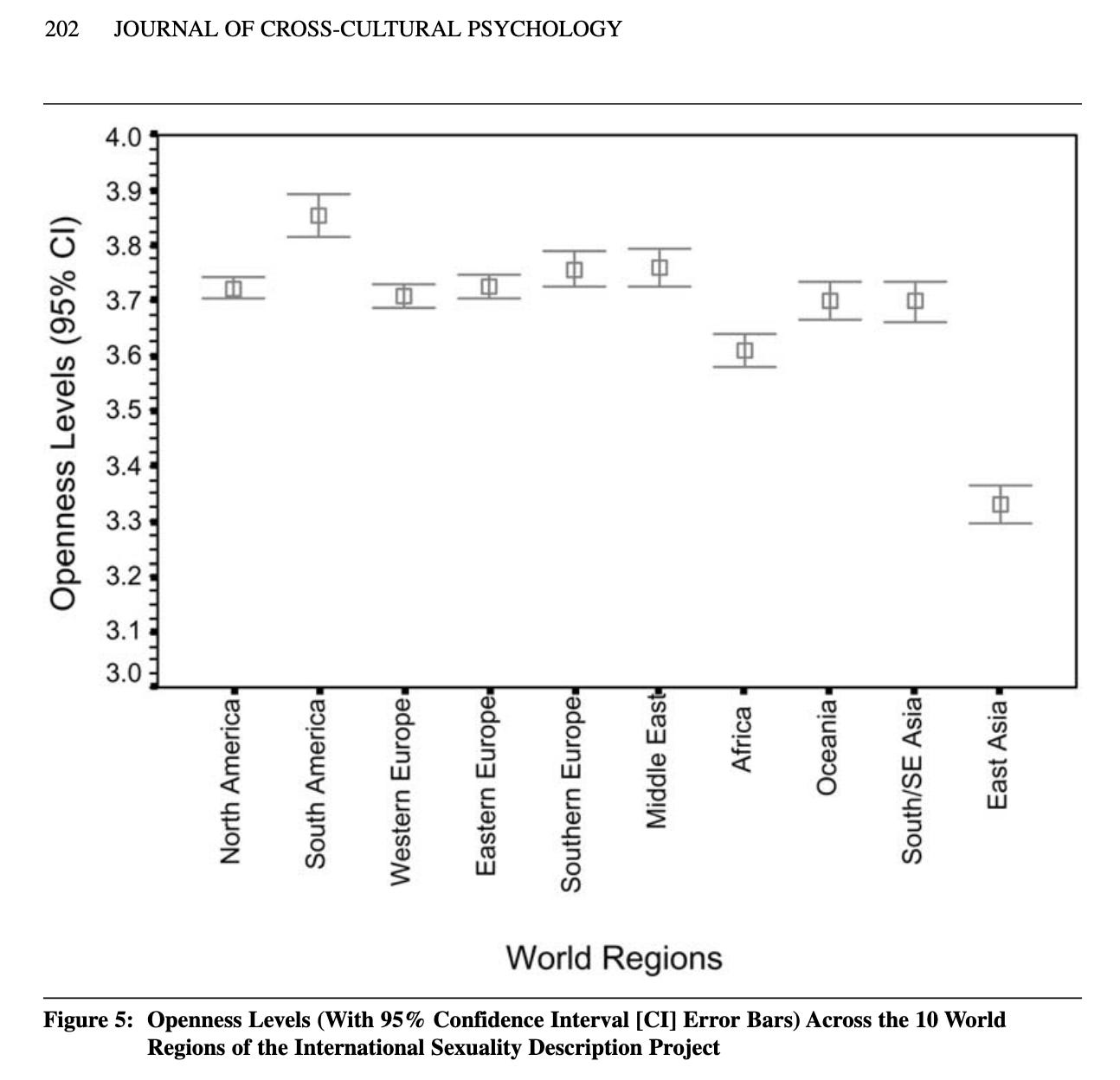
Perseverance: Both East Asians and Inuit/Siberians are described as highly persevering and industrious, with endurance of pain and persistence as a core cultural value, often vastly out-enduring Western observers in various environmental challenges. Pain endurance games were also noted in both cultures as a rite of passage in youth. The phenomenon of death by overwork is also most frequently occurring in East Asia, reflecting extreme task commitment under severe pressure.
The presence of several of these core ICE traits in East Asians was recently verified genomically by geneticists who linked polygenic scores to Big Five personality traits and tested for its frequencies across global populations (Piffer, 2025). Although cross-population methods of personality polygenic scores are new and will likely be refined in the future- early partial testing of a personality factor score consisting of polygenic scores linked to lower Extraversion (introversion), lower Neuroticism (emotional stability/impulsivity), and higher Agreeableness (social cohesion)- was shown to be indeed clustered the highest in East Asians and high altitude Central Asian populations, supporting adaptation to ICE environments and possibly amplified by the resultant culture. The results also show that several other populations traditionally underrepresented in aerospace might make suitable candidates for deep space and polar missions, including- Papuans, Mongols, Vietnamese, Finns, Sherpas, Tibetans, Yakuts, Kyrgyzs, Hui, Indonesians, Nepalis, the Saami, Indigenous Mexicans, the Amish and more. This new genomic data may help inform future aerospace, polar, and submarine personnel selection initiatives.
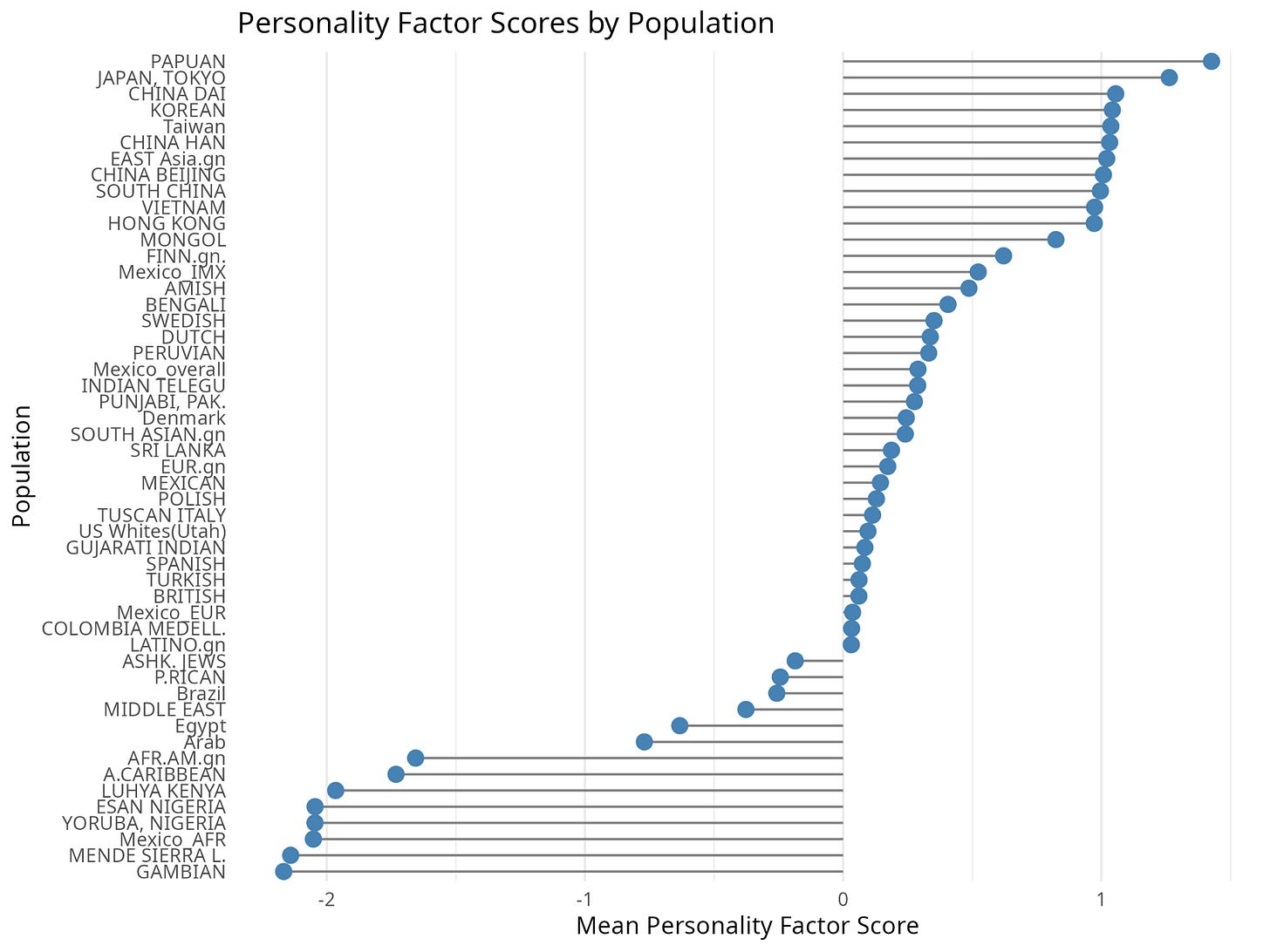
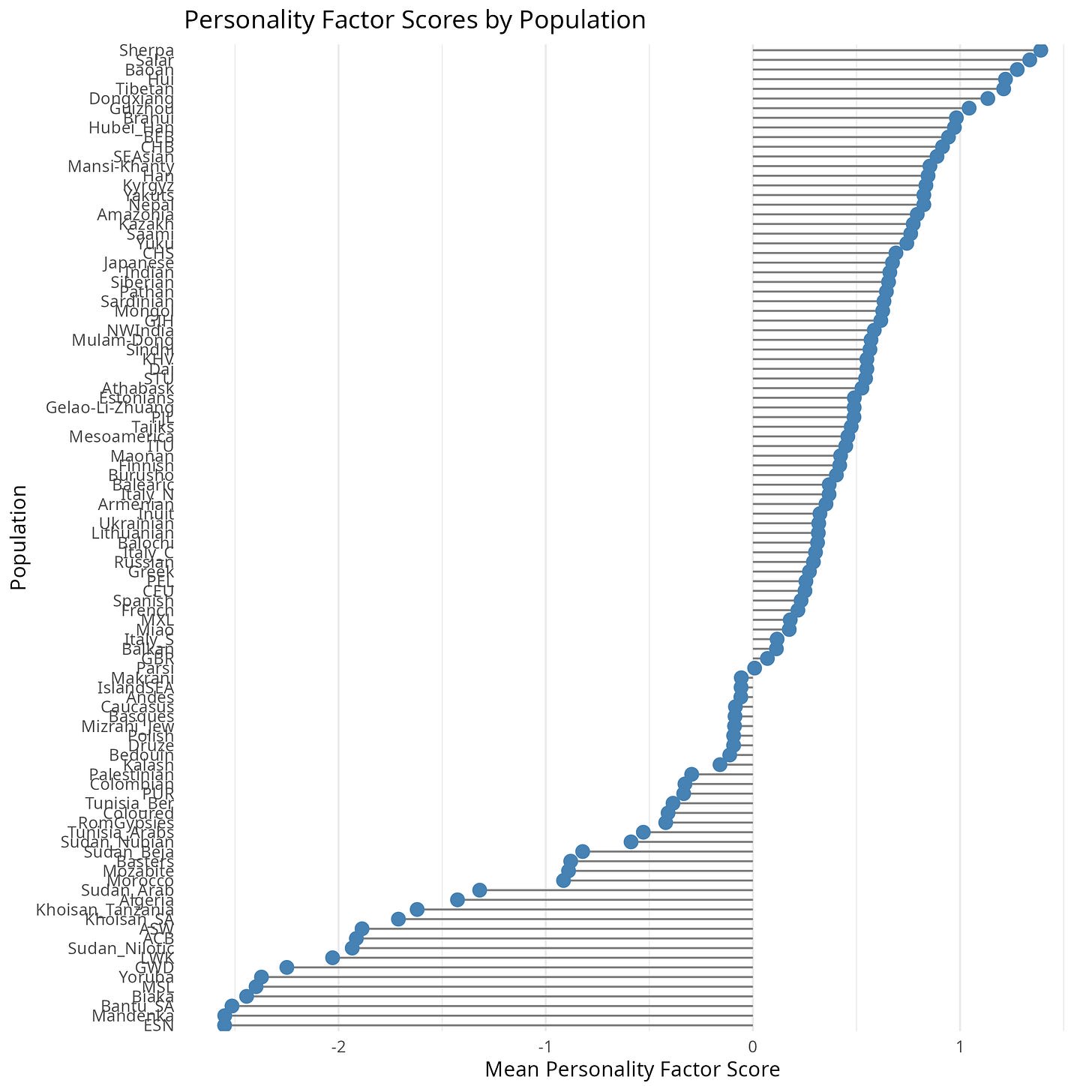
If East Asians are indeed ancestrally adapted to ancient polar ICE environments, would they theoretically perform better in modern polar expeditions or station life, and thus by extension, similar spacetravel and base environments? Some evidence already supports this prediction. Polar researchers found Japanese polar staff to have higher endurance, motivation, and calmness as compared to North American polar staff, despite experiencing more severe weather conditions (Weiss et al., 2000). Japanese and Chinese polar staff had notable stability of personality, emotions, and social support activity throughout winters, unlike other nationalities (Palinkas et al., 2004; Steel, 2015). Japanese staff remarkably did not have pathological depression during midwinters (Ikegawa et al., 1998), and even felt like polar winters to be easier to endure than life in Japan (Kuwabara et al., 2021). There may even be greater natural tolerance for confined environments, as it was discovered by Koh et al. (2017) that in Singapore, ethnic Chinese have only 1/6th the rate of claustrophobia than ethnic Malays and Indians, despite all three groups having the same national upbringing and Asian farming ancestry.
Aside from having an easier time on polar expeditions, polar bases/igloos, and in submarines- are there any other great benefits to being highly emotionally controlled, socially harmonious, self conscious, socially sensitive, introverted, cautious, and perseveringly industrious? Although this suite of personality traits perhaps produce less per capita entertainers for highly expressive Shakespearean theater, or are more likely to stand around awkwardly at the club, there appears to be a worthwhile compensatory upside to it all.
Since spacetravel and extraterrestrial base environments are analogs of polar ICE environments- East Asians and others who have more of these traits on average can look forward to becoming disproportionately in high demand in the workforce of the Space Age, the next evolutionary phase of mankind as we rise through the civilizational Kardashev scale. Life will supposedly resemble something out of Star Trek or Star Wars. Space passengers and eager Mars citizens can look forward to their spaceships and Mars bases being operated by folks (probably mostly East Asian due to the population size being reflected in employment staffing pools) that can stay clearheaded and keep their cool in all situations, get along with others at all times, be competent and industrious enough to solve all maintenance problems as they arise, and as a pleasant bonus in cramped spaces- be genetically devoid of body odor due to a selected variant on the ABCC11 gene (Yoshiura et al., 2006), a mutation selected for during the Ice Age likely due to stinky people being kicked out of confined igloos.
But what if I’m a emotionally expressive, hot tempered, insensitive, disagreeable extrovert?
Don’t worry my extroverted friends, most people do not perfectly fit the ICE suite of traits, so when a fully fledged Space Age kicks off, there will be a large market for specially designed Jumbo XXXL sized spacecraft with football field sized rooms, and O’Neill space cylinders with plenty of free greenery and room to roam, with rubber paddings and idiotproofed systems designed to mitigate the behaviors of the most disagreeable extroverts. As an extrovert leaning ambivert myself, I will personally wait for these vessels to be available before embarking on a space voyage.

When I used to daydream about the Space Age, envisioning myself on a summer stellar-safari aboard the SpaceX Interplanetary Luxury Cruiser with open bar and unlimited lobster, I would worry that the onboard Japanese buffet might be wack and inauthentic- perhaps with abominations like “Philadelphia rolls”, or nigiri with wasabi on the side instead of between the fish and rice. Now, due to the forecasted large East Asian workforce on spaceships, we can all feel assured knowing the East Asian cuisine on future space voyages will definitely be authentic, the service polite and excellent, and the piloting and base operations reliable and worry-free.

As space travel and bases shape the future of human life in the centuries ahead, the evidence documented here shows that East Asians who survived similar isolated, confined, and extreme dynamics in the Ice Age, and others who can reliably embody these traits like Inuit, Papuans, Amish, Siberians, Scandinavians, etc- will likely become a familiar crew sight in humanity’s upcoming interplanetary infrastructure. Calm, agreeable, hardworking, introverted individuals around the world should be excited to know that your personality is perfectly suited for space travel- and since personality is both genetically and culturally heritable, it bodes quite well for you and your offsprings’ employment outlook for the next ten bajillion years.
Now that’s a future worth looking forward to!
References
Biersner, R. J., & Hogan, R. (1984). Personality correlates of adjustment in isolated work groups. Journal of Research in Personality, 18(4), 491–496. https://doi.org/10.1016/0092-6566(84)90007-2
Bishop, S. L., Kobrick, R., Battler, M., & Binsted, K. (2010). FMARS 2007: Stress and coping in an arctic Mars simulation. Acta Astronautica, 66(9), 1353–1367. https://doi.org/10.1016/j.actaastro.2009.11.008
Burns, R., & Sullivan, P. (2000). Perceptions of danger, risk taking, and outcomes in a remote community—Robin Burns, Peter Sullivan, 2000. Retrieved September 5, 2023, fromhttps://doi.org/10.1177/00139160021972423
Golden, S. J., Chang, C.-H. (Daisy), & Kozlowski, S. W. J. (2018). Teams in isolated, confined, and extreme (ICE) environments: Review and integration. Journal of Organizational Behavior, 39(6), 701–715. https://doi.org/10.1002/job.2288
Gunderson, E. K. E. (1966). Selection for Antarctic service. U. S. Navy Medical Neuropsychiatric Research Unit. https://apps.dtic.mil/sti/citations/AD0632497
Gunderson, E. K. E. (1974). Psychological Studies in Antarctica. In Human Adaptability to Antarctic Conditions (pp. 115–131). American Geophysical Union (AGU). https://doi.org/10.1029/AR022p0115
Guthrie, R. D. (1996). The Mammoth Steppe and the origin of Mongoloids and their dispersal. In Prehistoric Mongoloid Dispersals. Oxford University Press.
Hanihara, K. (1974). Cold Climate and the Formation of the Modern Mongoloid. The Quaternary Research (Daiyonki-Kenkyu), 12(4), 265–269. https://doi.org/10.4116/jaqua.12.265
Hlusko, L. J., Carlson, J. P., Chaplin, G., Elias, S. A., Hoffecker, J. F., Huffman, M., Jablonski, N. G., Monson, T. A., O’Rourke, D. H., Pilloud, M. A., & Scott, G. R. (2018). Environmental selection during the last ice age on the mother-to-infant transmission of vitamin D and fatty acids through breast milk. Proceedings of the National Academy of Sciences, 115(19), E4426–E4432. https://doi.org/10.1073/pnas.1711788115
Ikegawa, M., Kimura, M., Makita, K., & Itokawa, Y. (1998). Psychological studies of a Japanese winter-over group at Asuka Station, Antarctica. Aviation, Space, and Environmental Medicine. https://www.semanticscholar.org/paper/Psychological-studies-of-a-Japanese-winter-over-at-Ikegawa-Kimura/889d65dd67f05abdb42faf01ca6f370e2d9642fd
Keinan, A., Mullikin, J. C., Patterson, N., & Reich, D. (2007). Measurement of the human allele frequency spectrum demonstrates greater genetic drift in East Asians than in Europeans. Nature Genetics, 39(10), 1251. https://doi.org/10.1038/ng2116
Koh, S. A. S., Lee, W., Rahmat, R., Salkade, P. R., & Li, H. (2017). Interethnic variation in the prevalence of claustrophobia during MRI at Singapore General Hospital: Does a wider bore MR scanner help?Proceedings of Singapore Healthcare, 26(4), 241–245. https://doi.org/10.1177/2010105817695819
Kuwabara, T., Naruiwa, N., Kawabe, T., Kato, N., Sasaki, A., Ikeda, A., Otani, S., Imura, S., Watanabe, K., & Ohno, G. (2021). Human change and adaptation in Antarctica: Psychological research on Antarctic wintering-over at Syowa station. International Journal of Circumpolar Health, 80(1), 1886704. https://doi.org/10.1080/22423982.2021.1886704
Kwon, B., & Nguyen, A. H. (2015). Reconsideration of the Epicanthus: Evolution of the Eyelid and the Devolutional Concept of Asian Blepharoplasty. Seminars in Plastic Surgery, 29(3), 171–183. https://doi.org/10.1055/s-0035-1556849
Mao, X., Zhang, H., Qiao, S., Liu, Y., Chang, F., Xie, P., Zhang, M., Wang, T., Li, M., Cao, P., Yang, R., Liu, F., Dai, Q., Feng, X., Ping, W., Lei, C., Olsen, J. W., Bennett, E. A., & Fu, Q. (2021). The deep population history of northern East Asia from the Late Pleistocene to the Holocene. Cell, 184(12), 3256-3266.e13. https://doi.org/10.1016/j.cell.2021.04.040
Nakayama, K., Ogawa, A., Miyashita, H., Tabara, Y., Igase, M., Kohara, K., Miki, T., Kagawa, Y., Yanagisawa, Y., Katashima, M., Onda, T., Okada, K., Fukushima, S., & Iwamoto, S. (2013). Positive natural selection of TRIB2, a novel gene that influences visceral fat accumulation, in East Asia. Human Genetics, 132(2), 201–217. https://doi.org/10.1007/s00439-012-1240-9
Norton, H., Kittles, R., Parra, E., McKeigue, P., Mao, X., Cheng, K., Canfield, V., Bradley, D., McEvoy, B., & Shriver, M. (2007). Genetic Evidence for the Convergent Evolution of Light Skin in Europeans and East Asians. Molecular Biology and Evolution, 24, 710–722. https://doi.org/10.1093/molbev/msl203
Palinkas, L. A., Johnson, J. C., Boster, J. S., Rakusa-Suszczewski, S., Klopov, V. P., Fu, X. Q., & Sachdeva, U. (2004). Cross-Cultural Differences in Psychosocial Adaptation to Isolated and Confined Environments. Aviation, Space, and Environmental Medicine, 75(11), 973–980.
Piffer, D. (2025). Testing the Late Pleistocene Arctic Origins of East Asian Psychology using Ancient and Modern DNA. Research Square. https://doi.org/10.21203/rs.3.rs-7696395/v1
Price, P. A., & Lannon, M. (2023). The Evolution of Chronic Primary Angle Closure Glaucoma in the Inuit and Oriental Eye. Journal of Community Medicine & Public Health. https://doi.org/10.29011/2577-2228.100290
Sazzini, M., Schiavo, G., De Fanti, S., Martelli, P. L., Casadio, R., & Luiselli, D. (2014). Searching for signatures of cold adaptations in modern and archaic humans: Hints from the brown adipose tissue genes. Heredity, 113(3), 259–267. https://doi.org/10.1038/hdy.2014.24
Steel, G. D. (2015). Extreme and Unusual. In D. Liggett, B. Storey, Y. Cook, & V. Meduna (Eds.), Exploring the Last Continent: An Introduction to Antarctica (pp. 361–377). Springer International Publishing. https://doi.org/10.1007/978-3-319-18947-5_17
Sun, D. (2025). Arctic instincts? The Late Pleistocene Arctic origins of East Asian psychology. Evolutionary Behavioral Sciences, 19(3), 227–265. https://doi.org/10.1037/ebs0000373
Weiss, K., Suedfeld, P., Steel, G. D., & Tanaka, M. (2000). Psychological adjustment during three Japanese Antarctic research expeditions. Environment and Behavior, 32(1), 142–156. https://doi.org/10.1177/00139160021972478
Yoshiura, K., Kinoshita, A., Ishida, T., Ninokata, A., Ishikawa, T., Kaname, T., Bannai, M., Tokunaga, K., Sonoda, S., Komaki, R., Ihara, M., Saenko, V. A., Alipov, G. K., Sekine, I., Komatsu, K., Takahashi, H., Nakashima, M., Sosonkina, N., Mapendano, C. K., … Niikawa, N. (2006). A SNP in the ABCC11 gene is the determinant of human earwax type. Nature Genetics, 38(3), 324–330. https://doi.org/10.1038/ng1733